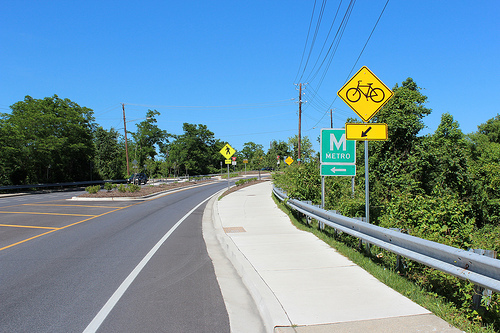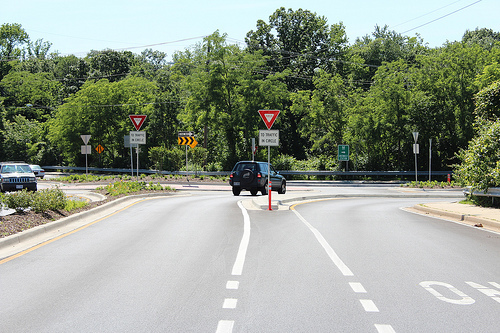Greenbelt roundabout includes innovative bike bypass
Last summer, the city of Greenbelt built a roundabout at the entrance to the Metro station with an innovative bike bypass. This improves access to the Metro for cyclists, motorists and transit riders alike.
Before the roundabout was built on Cherrywood Lane, there wasn’t even a stop sign, so anyone leaving the Metro had to wait for an opening in traffic. This led to significant backups of almost a half-mile, especially in the evening rush hour. Since the roundabout opened, I’ve never experienced a backup of more than 5 cars.
One of the tradeoffs, though, is that the roundabout required losing a section of the bike lanes on Cherrywood Lane, a key part of Greenbelt’s bike network. Westbound cyclists are headed downhill, so it’s fairly easy to merge into traffic. But eastbound cyclists are climbing a hill, and it can be daunting to merge into the faster traffic.
That’s where one of Greenbelt’s innovations comes in: a bypass. Where the bike lane ends before the roundabout, cyclists ascend a ramp to a widened sidewalk, then return to the bike lane on the other side.
Unfortunately, the bypass isn’t well marked and is easy to miss. Cyclists headed to the Metro should merge into traffic instead, but that’s not clear when the bypass begins due to a lack of signage at the decision point.
As the bike lane narrows, a sign directs cyclists to move onto the sidewalk, though it seems like it’s really meant for drivers. A pavement marking or even a sign that says “use path” with an upward right arrow, like this one in Atlanta, would be clearer.
Another problem is that pedestrians don’t realize that the sidewalk here doubles as a bikeway. Not expecting to see cyclists passing them, they walk in the middle, creating an opportunity for collisions.
Some paint could help this situation as well. In Atlanta, the city striped a bikeway on a short segment of sidewalk to direct bicyclists away from a short gap in the 5th Street bike lane.
For westbound cyclists, there is no bypass. The bike lane abruptly ends at a concrete splitter island, and riders are expected to merge into the car lane to go through the roundabout. The city did install an orange flexpost to improve visibility, but there’s no direction for cyclists or drivers, creating a safety hazard.
While there are raised crosswalks on the western and northern sides of the roundabout, improving pedestrian safety and slowing traffic, the city didn’t build one on the eastern leg. Drivers won’t slow down, making it harder for cyclists to merge into traffic. On top of that, the lack of a crosswalk means cyclists using the bypass have one fewer crossing to the Metro.
Even without the changes I’m suggesting, the roundabout is a huge improvement over the previous intersection. Greenbelt’s staff should be commended for designing fixes for the intersection. But this great project could be even better.
The Planning Department says that they will study the roundabout to determine whether further changes are necessary. Hopefully, some of these improvements will make the cut.






